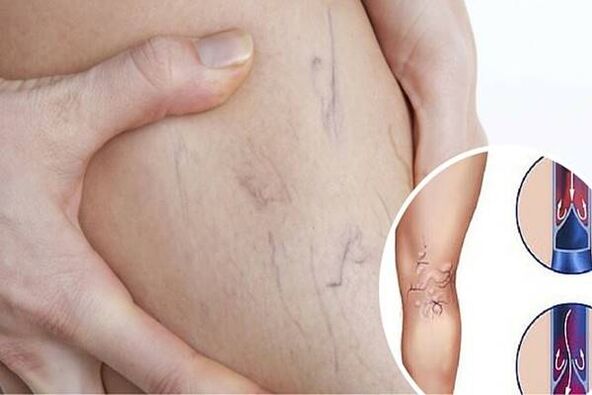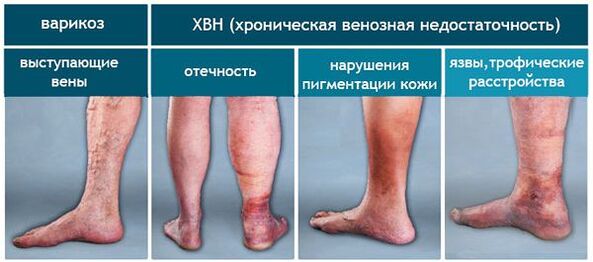According to statistics, about 83% of the population faces a disease like the varicose veins of the lower ends.Therefore, it is important to know how varicose veins seem in the initial phase.This will promptly identify the disease and prevent the development of possible complications.

Types of varicose veins
The disease of the veins, which is accompanied by their expansion, the destruction of the valve system can affect the various organs of the body.Therefore, the classification of this pathology is based on the place of its location.
According to the international classification of diseases of the tenth revision, these types of disease are distinguished:
- Varicose veins of the blood circulation system.
- Expansion of the veins of the digestive tract.
- The accumulation of numerous pathological clots in one place.
- Varicosis of lymph nodes and vases that are not arranged in other sections.
- Varicose expansion of the lower ends.
The use of ICD 10 in medical practice allows a phlebologist to make adequate diagnosis and differentiation of varicose veins.
In turn, the varicose veins at the lower ends, depending on the course stadium, are classified in the disease with:
- Ulcerative lesions.
- Progressive inflammatory processes.
- Ulcer and inflammation.
- Varicose veins of the legs or other part with damage to the skin.
- Lack of deformation of veins with ulcers, inflammatory processes.
Taking into account the main places of location of pathological changes, varicose veins are distinguished:
- Superficial veins.
- Deep veins.
- Reticular.
The wide classification of varicose veins is determined by a wide variety of options for the course of the disease.In the differentiation of the pathology, modern doctors use not only ICD-10, but also the classification of the disease by form.
In medical practice, these forms of varicose veins are distinguished:
- Partial damage to the blood vessels of the subcutaneous and intradermal type without reverse outflow.
- Segmentary defeat with an inverse flow of blood in all veins.
- A vast defeat with the unloading of pathologicalziology in subcutaneous veins.
- A common injury of veins with an abnormal discharge through deep veins.
The deformation of the veins and the dysfunction of the blood flow can be of different types.Only one doctor is able to correctly diagnose and establish a type of varicose expansion based on the results of a complex examination.

The degree of varicose veins
Depending on the process of progression of the disease, varicose veins have 4 development phases.Each of them is characterized by some symptoms.
- In the first phase, the gravity of the legs and the painful pain is felt.Vascular stars, knotted veins and swelling are displayed.Involuntary spasms of the calf muscles and the manifestation of combustion in the area of the foot are possible.It is characterized by the absence of stagnation in the bloodstream.
- The second degree of varicose veins is accompanied by the hunger for oxygen of the venous system.It is characterized by a rapid increase in the size and number of knots and vascular stars.This damage has clearly expressed boundaries, which contributes to their brighter event.Perhaps their grouping in the same area of defeat is small behind the area.In this case, the pain and swelling of soft tissues have improved.
- With the third degree of varicose veins, trophic injuries of the medial surface of the lower part of the leg are formed.It is characterized by the appearance of brown areas on the skin, which, with the progression of the disease, are covered with dry crust and crack.Based on their background, dermatitis is possible.The presence of great edema becomes dangerous.There is a lot of fatigue and pain.
- The fourth degree are the complications of the disease.They may appear in the form of development of inflammatory processes, trophic ulcers on the walls of the veins.Bleeding is possible with mechanical damage to seals.This degree is dangerous with the possibility of developing venous insufficiency, which can subsequently acquire a chronic form.
At the third and fourth phase, the patient begins to experience severe pain of a different nature, both in the muscles and along the venous trunks.It is extremely rare, there may be a breaking of knots, accompanied by an insignificant loss of blood.Very often, such a sign occurs at night.If, with varicose veins, hyperthermia and greater weakness appeared, this directly indicates the appearance of complications of the disease.
Varicosis itself is not a dangerous disease that is not susceptible to therapy.But it is worth noting that this pathology does not go by itself and is progressing quickly.The identification of the varicose veins of the first degree significantly increases the terms of rapid and successful recovery.The varicose veins launched the fourth degree are dangerous for the body and human life.

Phase of varicose veins of the lower ends
Varicose veins are characterized by different phases of the pathology.Each of which determines the prevalence of the disease and has some characteristics.There are many classifications of the phases of the varicose veins, each of which has its own symptoms and therapy.Especially in professional practice, modern doctors use the classification of varicose veins based on the degree of change in blood flow in the body vessels.
The following phases of the disease are distinguished:
- It is characterized by the presence of problems of the cosmetic event.There are no symptoms of thrombosis, but when they examine the patient, there are initial signs of the varicose veins on the legs.Depending on the etiology of the pathology, the compensation phase of varicose veins without adequate treatment throughout the year can develop in varicose veins of the second degree.
- The blood vessels are subject to deformation and clearly manifest themselves on the surface of the legs.The varicosis of this phase is accompanied by pain and swelling of the lower limbs.There is a feeling of gravity, feeling of burst and significantly increases the sensitivity of the skin.The swelling on the legs intensifies the evening and the next morning disappears.
- The visual signs of pathologists increase significantly.The venous networks and knots no longer become only in the area, but also in volumes.An intensive feeling of itching appears.The surface of the skin acquires a dark shadow, becomes dry and shiny.At this stage, a small bleeding occurs, which causes the deposition of emosiderin, leading to the hyperpigmentation of the skin in the affected areas.
The initial phase of the varicose veins for each organism proceeds differently.The intensity of the manifestation of its symptoms and the duration of this period is individual and depends on many factors.Therefore, with the manifestation of the minimum signs of pathology, it is necessary to immediately look for qualified medical care.The timely treatment will prevent the development of more serious stages of varicose veins.
The initial stage of the varicose veins on the legs: treatment of pathology
With varicose veins, the effectiveness of the therapeutic course depends directly on the timely manifestation of the pathology.The medical treatment qualified in the initial phase of the development of the disease allow to completely restore the integrity of the vascular wall and the functionality of the damaged veins.
The treatment of varicose veins of the initial phase is performed fully and consists of:
- Complex use of drugs.For complex effects on the veins, the oral intake of tablets of the tablets is carried out.The use of local drugs in the form of ointments and gel has a high therapeutic effect.
- Sclerotherapy.After the procedure, the mandatory use of a special compression knitwear.The effectiveness of sclerotherapy explains its use in the compensation phase for varicose veins of the lower ends.
- Ozonotherapy.It refers to the treatment, which acts as one of the components of the complex therapy of varicose veins in the initial phase.These procedures improve cell nutrition with oxygen and stimulate blood circulation through the veins.As a result, glue the affected walls of the blood vessels.
Each of varicose veins therapy methods requires prescription and control mandatory doctors.The car -mediation of varicose veins is severely prohibited.
Varicose veins at the lower ends of the initial degree are difficult to diagnose independently.Visual information on the Internet contributes to visual familiarization with characteristic signs of pathology.



















